Messier Catalog: M41 - M50
M31 - M40 | Messier Menu | M51 - M60
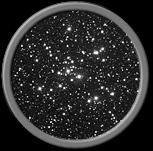 M41
Galactic Cluster in Canis Major
Common Names: None
2287
4.6
6h 47m
-20° 44'
M41
Galactic Cluster in Canis Major
Common Names: None
2287
4.6
6h 47m
-20° 44'
M41 is an open, or galactic, cluster located within the constellation of Canis Major. This cluster is located about 4 degrees South of Sirius, the brightest star in the night sky. M41 contains about 100 stars of varying colors. Several of these stars are red giants, the brightest of which is about 700 times brighter than the Sun. This cluster is about 26 light-years across and is situated approximately 2,300 light-years from Earth. M41's age is estimated at about 190 million years. It is easily visible with a pair of binoculars.
Image credit: NOAO/AURA/NSF
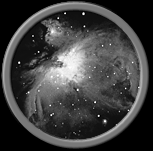 M42
Diffuse Nebula in Orion
Common Names: Orion Nebula, Great Nebula
1976
4.0
5h 35.4m
-5° 27'
M42
Diffuse Nebula in Orion
Common Names: Orion Nebula, Great Nebula
1976
4.0
5h 35.4m
-5° 27'
Located in the constellation of Orion is one of the most impressive sights in the night sky. M42, also known as the Orion Nebula or the Great Nebula of Orion, is a gigantic cloud of gas and dust over 30 light-years in diameter. It is located about 1,500 light-years from the Earth. M42 is a site of active star formation, and the stars within this nebula cause it to shine with a magnitude of 4. This makes it one of the few nebulae that can be seen with the naked eye. The most famous of these stars is a small cluster known as the Trapezium. A pair of binoculars will show the basic structure of this nebula, while a small telescope will reveal intricate details within its dusty lanes.
Image credit: Clipart.com
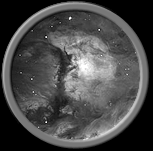 M43
Diffuse Nebula in Orion
Common Names: None
1982
9.0
5h 35.6m
-5° 15'
M43
Diffuse Nebula in Orion
Common Names: None
1982
9.0
5h 35.6m
-5° 15'
M43 is also located in the constellation of Orion, and is actually part of M42, the Orion Nebula. It is visually separated from the rest of M42 by an impressive dark lane of dense dust. The dust actually lies between the nebula and us. If you could see M42 from the other side of the dust lane it would appear to be all in one piece. M43 is easily visible in a 4-inch telescope, but an 8-inch instrument will reveal dark features and details along the nebula's eastern border.
Image credit: NASA/ESA
 M44
Galactic Cluster in Cancer
Common Names: Beehive Cluster, Praesepe
2632
3.7
8h 40.1m
+19° 59'
M44
Galactic Cluster in Cancer
Common Names: Beehive Cluster, Praesepe
2632
3.7
8h 40.1m
+19° 59'
Located in the constellation of Cancer is an impressive galactic cluster of stars known as M44. This famous cluster is also known as Praesepe, and more recently, the Beehive Cluster. The Beehive was given this name because to some it resembles a swarm of bees. It is one of the few deep-sky objects visible to the naked eye and has been known since ancient times. M44 consists of about 350 stars, 40 of which are bright enough to be seen in a small telescope. This cluster is about 577 light-years from Earth and is believed to be approximately 400 million years old.
Image credit: NOAO/AURA/NSF
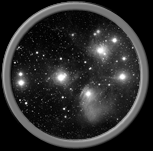 M45
Galactic Cluster in Taurus
Common Names: Pleiades, Seven Sisters
N/A
1.6
3h 47m
+24° 07'
M45
Galactic Cluster in Taurus
Common Names: Pleiades, Seven Sisters
N/A
1.6
3h 47m
+24° 07'
M45 is an object that has been known since the earliest times. Most commonly known as the Pleiades, it is a galactic cluster of about 500 young stars located within the constellation of Taurus. This cluster has also been named the Seven Sisters, after its seven brightest stars. These stars can easily be seen with the naked eye. The Pleiades are believed to be very young - only 100 million years old. They are located only 380 light-years from Earth. Photographs of the cluster reveal traces of the nebula out of which the stars originally formed. Binoculars will show much more than the seven brightest stars, and a large telescope will show reveal some of the nebulous material surrounding the stars.
Image credit: Clipart.com
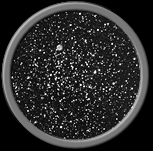 M46
Galactic Cluster in Puppis
Common Names: None
2437
6.0
7h 41.8m
-14° 49'
M46
Galactic Cluster in Puppis
Common Names: None
2437
6.0
7h 41.8m
-14° 49'
Located in the constellation Puppis, M46 is an open cluster of about 500 stars. About 150 of these have a magnitude of between 10 and 13. This cluster is believed to be around 300 million years old. It is 30 light-years across and is located approximately 5,400 light-years from the Earth. A large telescope will reveal a small planetary nebula within the cluster. This nebula is not a member of M46 but is actually located between the cluster and us. This object is easily visible in a pair of binoculars with good observing conditions.
Image credit: N.A.Sharp/NOAO/AURA/NSF
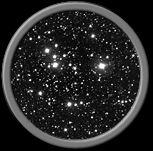 M47
Galactic Cluster in Puppis
Common Names: None
2422
5.2
7h 36.6m
-14° 30'
M47
Galactic Cluster in Puppis
Common Names: None
2422
5.2
7h 36.6m
-14° 30'
Another open star cluster in Puppis is M47. This is a bright cluster than can be seen with the naked eye under good conditions. It is a tight cluster, containing about 50 bright stars in a region approximately 12 light-years in diameter. M47 is located about 1,600 light-years from Earth. This close proximity gives the cluster an apparent diameter about equal to that of the full moon. With a magnitude of 5.2, M47 is an excellent object for observing with binoculars. A small telescope will reveal more of the fainter stars in the cluster.
Image credit: NOAO/AURA/NSF
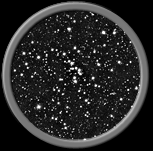 M48
Galactic Cluster in Hydra
Common Names: None
2548
5.5
8h 13.8m
-4° 48'
M48
Galactic Cluster in Hydra
Common Names: None
2548
5.5
8h 13.8m
-4° 48'
Located in the constellation of Hydra, M48 is an open cluster of about 80 stars. 50 of these are brighter than magnitude 13 and are easily visible in binoculars and small telescopes. The cluster is easily visible to the naked eye under ideal observing conditions. M48 is about 23 light-years in diameter and is located some 1,500 light-years from Earth. Its age is estimated at about 300 million years.
Image credit: NOAO/AURA/NSF
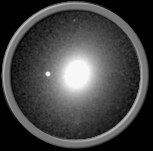 M49
Galaxy in Virgo
Common Names: None
4472
8.4
12h 29.8m
+8° 00'
M49
Galaxy in Virgo
Common Names: None
4472
8.4
12h 29.8m
+8° 00'
M49 is a small elliptical galaxy located in the constellation Virgo. It was the first member of the Virgo cluster of galaxies discovered by Messier in 1771. At a magnitude of 8.4, it is also the brightest of these galaxies. M49 is believed to be about 160,000 light-years in diameter, and is located approximately 60 million light-years from us. It will be visible as a faint point of light with binoculars. Large telescopes will reveal the fuzzy, nebulous nature of this object, as well as its bright center.
Image credit: Two Micron All Sky Survey (2MASS)
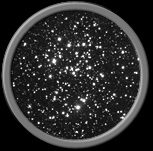 M50
Galactic Cluster in Monoceros
Common Names: None
2323
6.3
7h 03.2m
-8° 20'
M50
Galactic Cluster in Monoceros
Common Names: None
2323
6.3
7h 03.2m
-8° 20'
Located in the constellation of Monoceros is an open cluster of stars known as M50. This cluster is estimated to contain about 200 stars. It is about 10 light-years in diameter and is believed to be located around 3,000 light-years from Earth. The appearance of this cluster has been described as a heart-shape. With a magnitude of 6.3, M50 is easily visible with a pair of binoculars. Telescopes will reveal more of the fainter members of the group.
Image credit: NOAO/AURA/NSF

 M41
Galactic Cluster in Canis Major
M41
Galactic Cluster in Canis Major M42
Diffuse Nebula in Orion
M42
Diffuse Nebula in Orion M43
Diffuse Nebula in Orion
M43
Diffuse Nebula in Orion M44
Galactic Cluster in Cancer
M44
Galactic Cluster in Cancer M45
Galactic Cluster in Taurus
M45
Galactic Cluster in Taurus M46
Galactic Cluster in Puppis
M46
Galactic Cluster in Puppis M47
Galactic Cluster in Puppis
M47
Galactic Cluster in Puppis M48
Galactic Cluster in Hydra
M48
Galactic Cluster in Hydra M49
Galaxy in Virgo
M49
Galaxy in Virgo M50
Galactic Cluster in Monoceros
M50
Galactic Cluster in Monoceros